Tensile Behavior, Constitutive Model, and Deformation Mechanisms of MarBN Steel at Various Temperatures and Strain Rates
Abstract
:1. Introduction
2. Experimental Procedures
3. Results and Discussion
3.1. Initial Microstructure Characterizations
3.2. Dependence on Temperatures and Strain Rates of Tensile Behavior
3.3. Fracture Pattern and Deformation Microstructure
3.4. Constitutive Models
4. Conclusions
- (1)
- MarBN steel has a martensitic lath structure with an average grain size of about 13 μm, including Fe-Cr-rich MX carbides along with the martensitic laths and Fe-rich M3C carbides within PAGBs.
- (2)
- The flow stress curves present two modes, i.e., hardening behavior at RT and softening behavior at 630 °C from yield point to ultimate tensile strength. The tensile behavior is sensitive to the strain rate, especially at 630 °C, which is the balance between the average dislocation velocity and dislocation density. In addition, the serrated flow is observed under different strain rates at 630 °C due to the dynamic strain aging behavior.
- (3)
- The deformation mechanisms are also related to the temperatures and strain rates. Apart from the presence of tenacity nets, tearing pattern, and serpentine sliding along the wall of the dimples at RT and 630 °C, DRXed grains are solely observed at high temperature which improves the elongation of MarBN steel. Combined with the strain hardening rate curves, dimples at low strain rates are large in size and small in number, reducing the plastic deformation capacity, which is due to the growth and coalescence of dimples benefit from sufficient responding time.
- (4)
- Three typical constitutive equations are employed to quantitatively describe the tensile deformation behavior of MarBN steel under different strain rates at RT and 630 °C. A fifth-order polynomial is used to fit the material constants. After that, the constitutive model of flow stress for MarBN steel is developed based on the hyperbolic sine law.
Author Contributions
Funding
Institutional Review Board Statement
Informed Consent Statement
Data Availability Statement
Conflicts of Interest
References
- Abe, F.; Barnard, P.; Blum, R.; Chai, G.; de Barbadillo, J.J.; Di Gianfrancesco, A.; Forsberg, U.; Fukuda, M.; Hald, J.; Klöwer, J.; et al. Materials for Ultra-Supercritical and Advanced Ultra-Supercritical Power Plants; Woodhead Publishing: Sawston, UK, 2017. [Google Scholar]
- Viswanathan, R.; Henry, J.F.; Tanzosh, J.; Stanko, G.; Shingledecker, J.; Vitalis, B.; Purgert, R.U.S. Program on Materials Technology for Ultra-Supercritical Coal Power Plants. J. Mater. Eng. Perform. 2013, 22, 2904–2915. [Google Scholar] [CrossRef]
- Dube, S.K. Technical analysis for preferring more efficient and green technology for thermal power generation: “Advanced-Ultra Supercritical 760 °C”. Int. J. Sci. Res. Publ. 2018, 8, 622–635. [Google Scholar] [CrossRef]
- Das, B.; Singh, A. Understanding strain controlled low cycle fatigue response of P91 steel through experiment and cyclic plasticity modeling. Fusion Eng. Des. 2019, 138, 125–137. [Google Scholar] [CrossRef]
- Li, D.F.; Barrett, R.A.; O’Donoghue, P.E.; Hyde, C.J.; O’Dowd, N.P.; Leen, S.B. Micromechanical finite element modelling of thermo-mechanical fatigue for P91 steels. Int. J. Fatigue 2016, 87, 192–202. [Google Scholar] [CrossRef]
- Barrett, R.A.; Farragher, T.P.; O’Dowd, N.P.; O’Donoghue, P.E.; Leen, S.B. Multiaxial cyclic viscoplasticity model for high temperature fatigue of P91 steel. Mater. Sci. Technol. 2014, 30, 67–74. [Google Scholar] [CrossRef]
- Guo, S.; Zhang, W.; Yin, P.; Ma, T.-H.; Wen, J.-B.; Zhang, G.-D.; Xue, F.; Zhao, Y.-F.; Zhou, C.-Y. Cyclic deformation behavior and life prediction of P92 steel welded joints under thermomechanical fatigue loadings. Int. J. Fatigue 2021, 147, 106183. [Google Scholar] [CrossRef]
- Zhang, T.; Wang, X.; Ji, Y.; Zhang, W.; Hassan, T.; Gong, J. P92 steel creep-fatigue interaction responses under hybrid stress-strain controlled loading and a life prediction model. Int. J. Fatigue 2020, 140, 105837. [Google Scholar] [CrossRef]
- Gopinath, K.; Gupta, R.K.; Sahu, J.K.; Ray, P.K.; Ghosh, R.N. Designing P92 grade martensitic steel header pipes against creep–fatigue interaction loading condition: Damage micromechanisms. Mater. Des. 2015, 86, 411–420. [Google Scholar] [CrossRef]
- Zhang, Z.; Hu, Z.; Schmauder, S.; Zhang, B.; Wang, Z. Low cycle fatigue properties and microstructure of P92 ferritic-martensitic steel at room temperature and 873 K. Mater. Charact. 2019, 157, 109923. [Google Scholar] [CrossRef]
- Abe, F. Precipitate design for creep strengthening of 9% Cr tempered martensitic steel for ultra-supercritical power plants. Sci. Technol. Adv. Mater. 2008, 9, 013002. [Google Scholar] [CrossRef]
- Abe, F. Research and Development of Heat-Resistant Materials for Advanced USC Power Plants with Steam Temperatures of 700 °C and Above. Engineering 2015, 1, 211–224. [Google Scholar] [CrossRef] [Green Version]
- Choudhary, B.K.; Christopher, J. Influence of temperature and strain rate on tensile deformation and fracture behaviour of boron added P91 steel. Int. J. Press. Vessels Pip. 2019, 171, 153–161. [Google Scholar] [CrossRef]
- Chen, H.; Yang, R.; Al-Abedy, H.K.; Li, H.; Sun, W.; Jones, I.A. Characterisation of deformation process and fracture mechanisms of P91 steel at 600 °C in small punch tensile testing. Mater. Charact. 2020, 168, 110514. [Google Scholar] [CrossRef]
- Zhang, J.-Y.; Jiang, P.; Zhu, Z.-l.; Chen, Q.; Zhou, J.; Meng, Y. Tensile properties and strain hardening mechanism of Cr-Mn-Si-Ni alloyed ultra-strength steel at different temperatures and strain rates. J. Alloys Compd. 2020, 842, 155856. [Google Scholar] [CrossRef]
- Pandey, C.; Mahapatra, M.M.; Kumar, P.; Saini, N. Effect of normalization and tempering on microstructure and mechanical properties of V-groove and narrow-groove P91 pipe weldments. Mater. Sci. Eng. A 2017, 685, 39–49. [Google Scholar] [CrossRef]
- Pandey, C.; Giri, A.; Mahapatra, M.M. Evolution of phases in P91 steel in various heat treatment conditions and their effect on microstructure stability and mechanical properties. Mater. Sci. Eng. A 2016, 664, 58–74. [Google Scholar] [CrossRef]
- Wang, X.; Zhang, W.; Ni, J.; Zhang, T.; Gong, J.; Wahab, M.A. Quantitative description between pre-fatigue damage and residual tensile properties of P92 steel. Mater. Sci. Eng. A 2019, 744, 415–425. [Google Scholar] [CrossRef]
- Sainath, G.; Choudhary, B.K.; Christopher, J.; Isaac Samuel, E.; Mathew, M.D. Applicability of Voce equation for tensile flow and work hardening behaviour of P92 ferritic steel. Int. J. Press. Vessels Pip. 2015, 132, 1–9. [Google Scholar] [CrossRef]
- Zhang, W.; Wang, X.; Chen, H.; Zhang, T.; Gong, J. A modified constitutive model for tensile deformation of 9% Cr steel under prior fatigue loading. Mech. Mater. 2019, 136, 103093. [Google Scholar] [CrossRef]
- Zhang, X.; Wang, T.; Gong, X.; Li, Q.; Liu, Y.; Wang, Q.; Zhang, H.; Wang, Q. Low cycle fatigue properties, damage mechanism, life prediction and microstructure of MarBN steel: Influence of temperature. Int. J. Fatigue 2021, 144, 106070. [Google Scholar] [CrossRef]
- Zhang, H.; Wang, Q.; Gong, X.; Wang, T.; Pei, Y.; Zhang, W.; Liu, Y.; Wang, C.; Wang, Q. Comparisons of low cycle fatigue response, damage mechanism, and life prediction of MarBN steel under stress and strain-controlled modes. Int. J. Fatigue 2021, 149, 106291. [Google Scholar] [CrossRef]
- Li, M.; Benaarbia, A.; Morris, A.; Sun, W. Assessment of potential service-life performance for MarBN steel power plant header under flexible thermomechanical operations. Int. J. Fatigue 2020, 135, 105565. [Google Scholar] [CrossRef]
- Guo, J.; Xu, X.; Jepson, M.A.E.; Thomson, R.C. Influence of weld thermal cycle and post weld heat treatment on the microstructure of MarBN steel. Int. J. Press. Vessels Pip. 2019, 174, 13–24. [Google Scholar] [CrossRef]
- Gong, X.; Wang, T.; Li, Q.; Liu, Y.; Zhang, H.; Zhang, W.; Wang, Q.; Wang, Q. Cyclic responses and microstructure sensitivity of Cr-based turbine steel under different strain ratios in low cycle fatigue regime. Mater. Des. 2021, 201, 109529. [Google Scholar] [CrossRef]
- ASTM E8/E8M-09; Standard Test Methods for Tension Testing of Metallic Materials. ASTM International: West Conshohocken, PA, USA, 2009.
- ASTM E21-20; Standard Test Methods for Elevated Temperature Tension Tests of Metallic Materials. ASTM International: West Conshohocken, PA, USA, 2020.
- Jeong, H.T.; Park, H.K.; Kim, W.J. Hot deformation behavior and processing map of a Sn0.5CoCrFeMnNi high entropy alloy with dual phases. Mater. Sci. Eng. A 2021, 801, 140394. [Google Scholar] [CrossRef]
- Callister, W.D. Fundamentals of Materials Science and Engineering; John Wiley and Sons: London, UK, 2001. [Google Scholar]
- Meyers, M.A.; Chawla, K.K. Mechanical Behavior of Materials; Cambridge University Press: Cambridge, UK, 2009. [Google Scholar]
- Zhang, L.; Guo, P.; Wang, G.; Liu, S. Serrated flow and failure behaviors of a Hadfield steel at various strain rates under extensometer-measured strain control tensile load. J. Mater. Res. Technol. 2020, 9, 1500–1508. [Google Scholar] [CrossRef]
- Huang, A.; Wang, Z.; Liu, X.; Yuan, Q.; Ye, J.; Zhang, Y. Dynamic strain aging and serrated flow behavior of Cr-Ti-B low carbon steel during warm deformation. Mater. Charact. 2021, 172, 110828. [Google Scholar] [CrossRef]
- Verma, P.; Sudhakar Rao, G.; Chellapandi, P.; Mahobia, G.S.; Chattopadhyay, K.; Santhi Srinivas, N.C.; Singh, V. Dynamic strain ageing, deformation, and fracture behavior of modified 9Cr–1Mo steel. Mater. Sci. Eng. A 2015, 621, 39–51. [Google Scholar] [CrossRef]
- Zhang, H.; Li, P.; Gong, X.; Wang, T.; Li, L.; Liu, Y.; Wang, Q. Tensile properties, strain rate sensitivity and failure mechanism of single crystal superalloys CMSX-4. Mater. Sci. Eng. A 2020, 782, 139105. [Google Scholar] [CrossRef]
- Wang, Q.; Wang, Q.; Gong, X.; Wang, T.; Zhang, W.; Li, L.; Liu, Y.; He, C.; Wang, C.; Zhang, H. A comparative study of low cycle fatigue behavior and microstructure of Cr-based steel at room and high temperatures. Mater. Des. 2020, 195, 109000. [Google Scholar] [CrossRef]
- Poliak, E.I.; Jonas, J.J. A one-parameter approach to determining the critical conditions for the initiation of dynamic recrystallization. Acta Mater. 1996, 44, 127–136. [Google Scholar] [CrossRef]
- Meyers, M.A. Dynamic Behavior of Materials; Wiley-Interscience: New York, NY, USA, 1994. [Google Scholar]
- Fisher, J.C. Dislocations and Mechanical Properties of Crystals; Wiley: New York, NY, USA, 1957. [Google Scholar]
- Ren, J.; Yu, L.; Liu, Y.; Ma, Z.; Liu, C.; Li, H.; Wang, H. Microstructure evolution and tensile properties of an Al added high-Cr ODS steel during thermal aging at 650 °C. Fusion Eng. Des. 2020, 157, 111700. [Google Scholar] [CrossRef]
- Xiao, B.; Xu, L.; Zhao, L.; Jing, H.; Han, Y. Tensile mechanical properties, constitutive equations, and fracture mechanisms of a novel 9% chromium tempered martensitic steel at elevated temperatures. Mater. Sci. Eng. A 2017, 690, 104–119. [Google Scholar] [CrossRef]
- Wen, D.; Yue, T.; Xiong, Y.; Wang, K.; Wang, J.; Zheng, Z.; Li, J. High-temperature tensile characteristics and constitutive models of ultrahigh strength steel. Mater. Sci. Eng. A 2021, 803, 140491. [Google Scholar] [CrossRef]
- Ashby, M.F.; Gandhi, C.; Taplin, D.M.R. Overview No. 3 Fracture-mechanism maps and their construction for f.c.c. metals and alloys. Acta Metall. 1979, 27, 699–729. [Google Scholar] [CrossRef]
- Zener, C.; Hollomon, J.H. Effect of Strain Rate Upon Plastic Flow of Steel. J. Appl. Phys. 1944, 15, 22–32. [Google Scholar] [CrossRef]
- Sellars, C.M.; McTegart, W.J. On the mechanism of hot deformation. Acta Metall. 1966, 14, 1136–1138. [Google Scholar] [CrossRef]
- Peng, X.; Guo, H.; Shi, Z.; Qin, C.; Zhao, Z. Constitutive equations for high temperature flow stress of TC4-DT alloy incorporating strain, strain rate and temperature. Mater. Des. 2013, 50, 198–206. [Google Scholar] [CrossRef]
- Xu, W.; Zou, M.; Zhang, L. Constitutive analysis to predict the hot deformation behavior of 34CrMo4 steel with an optimum solution method for stress multiplier. Int. J. Press. Vessels Pip. 2014, 123, 70–76. [Google Scholar] [CrossRef]
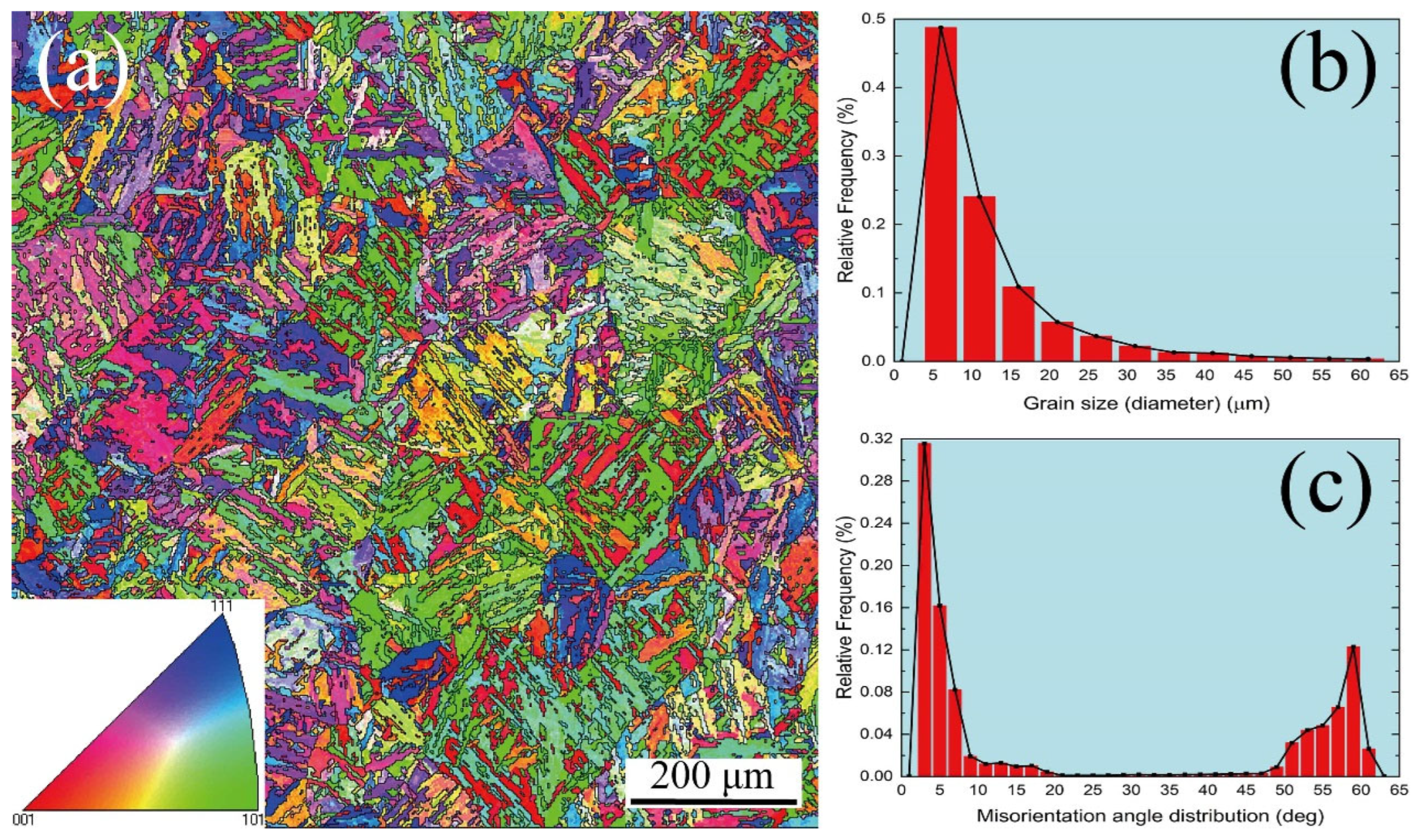
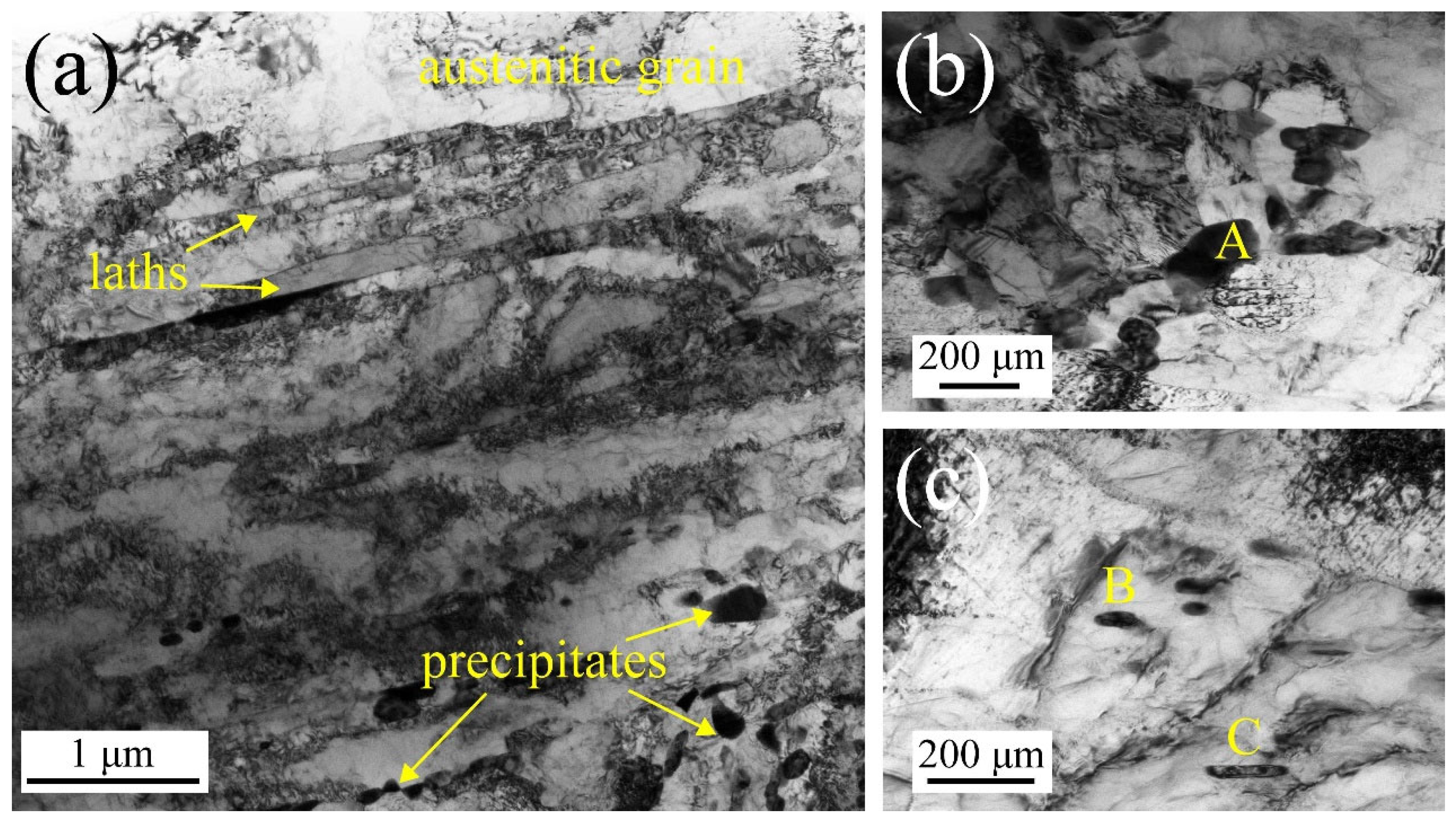
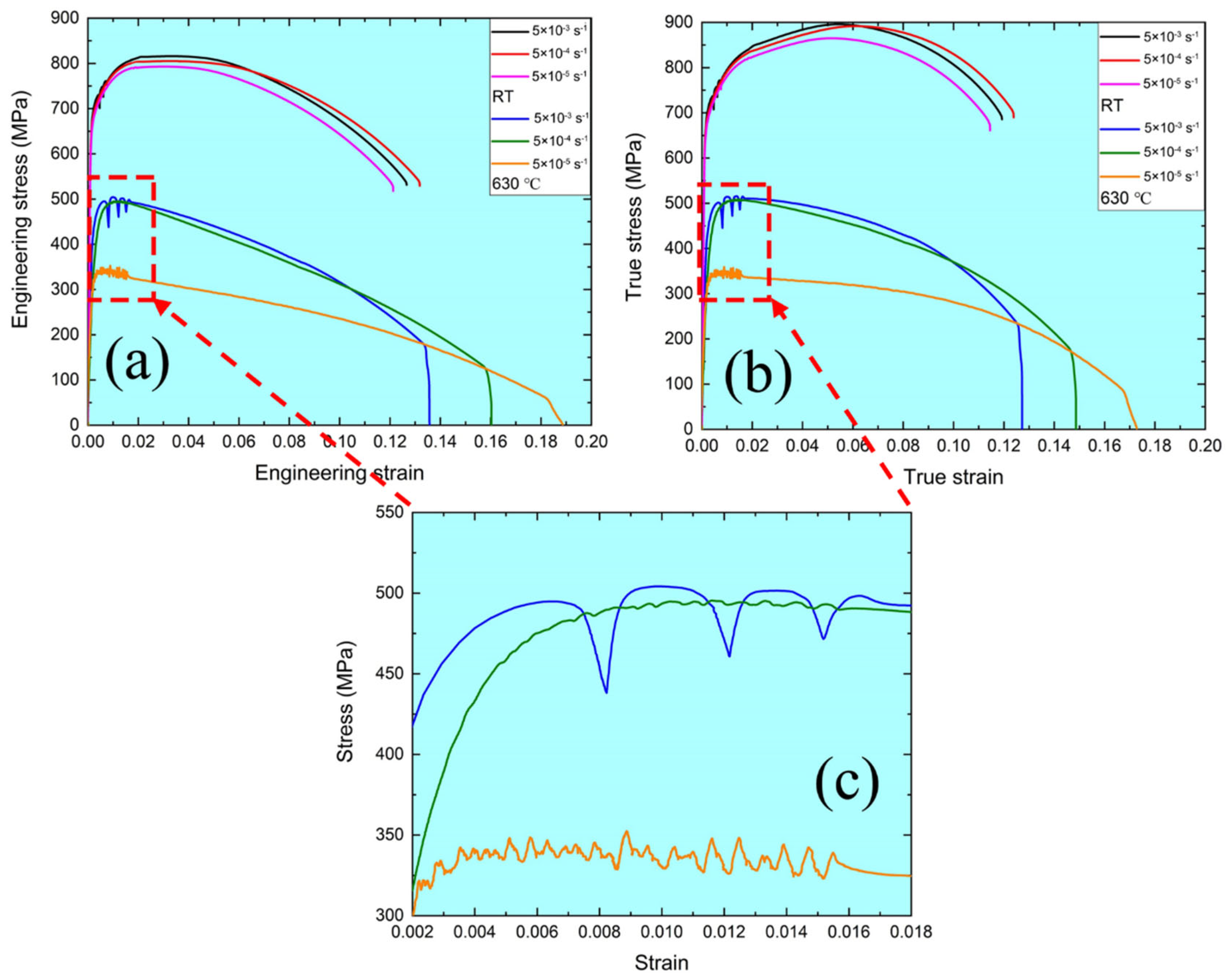

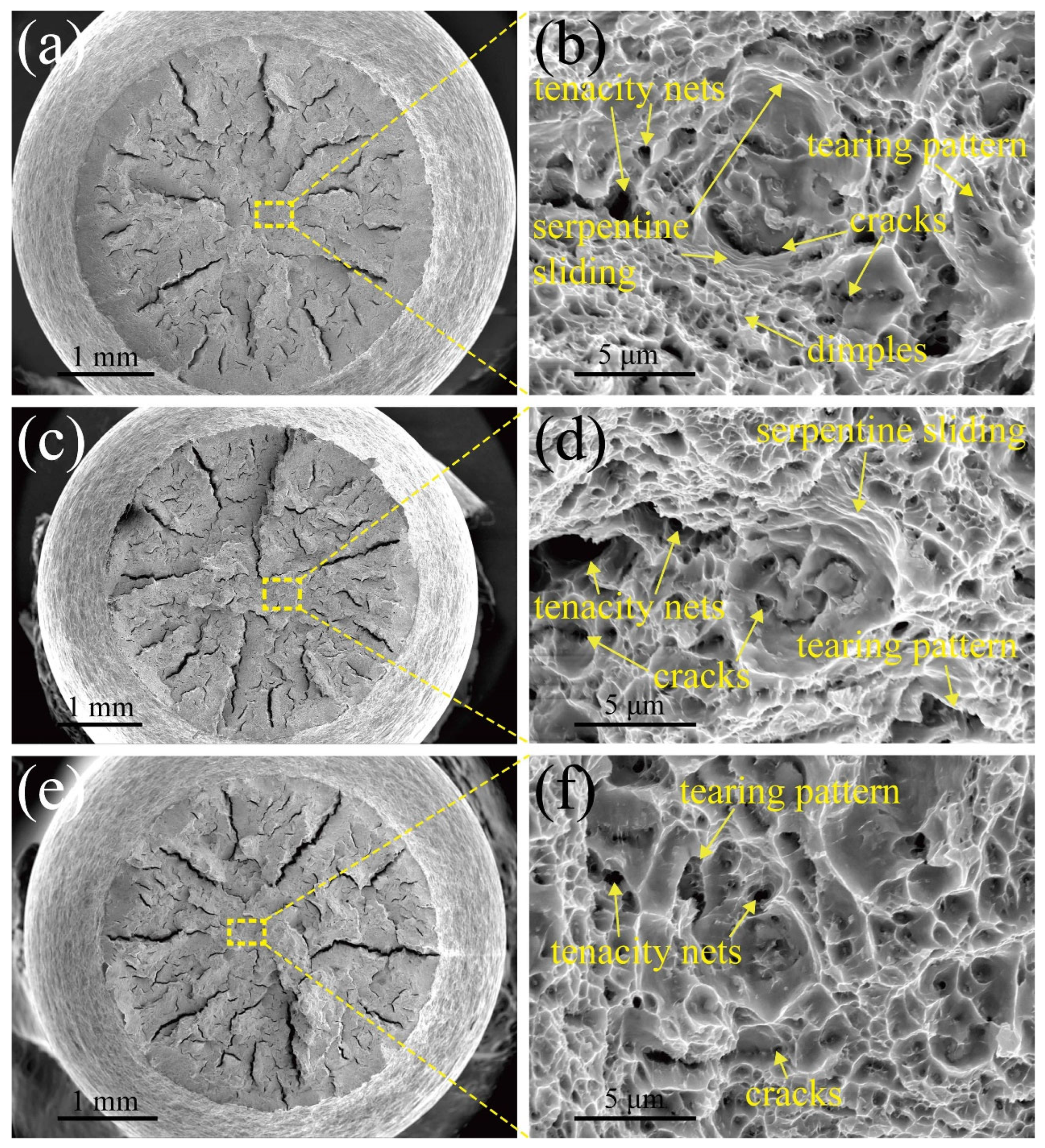
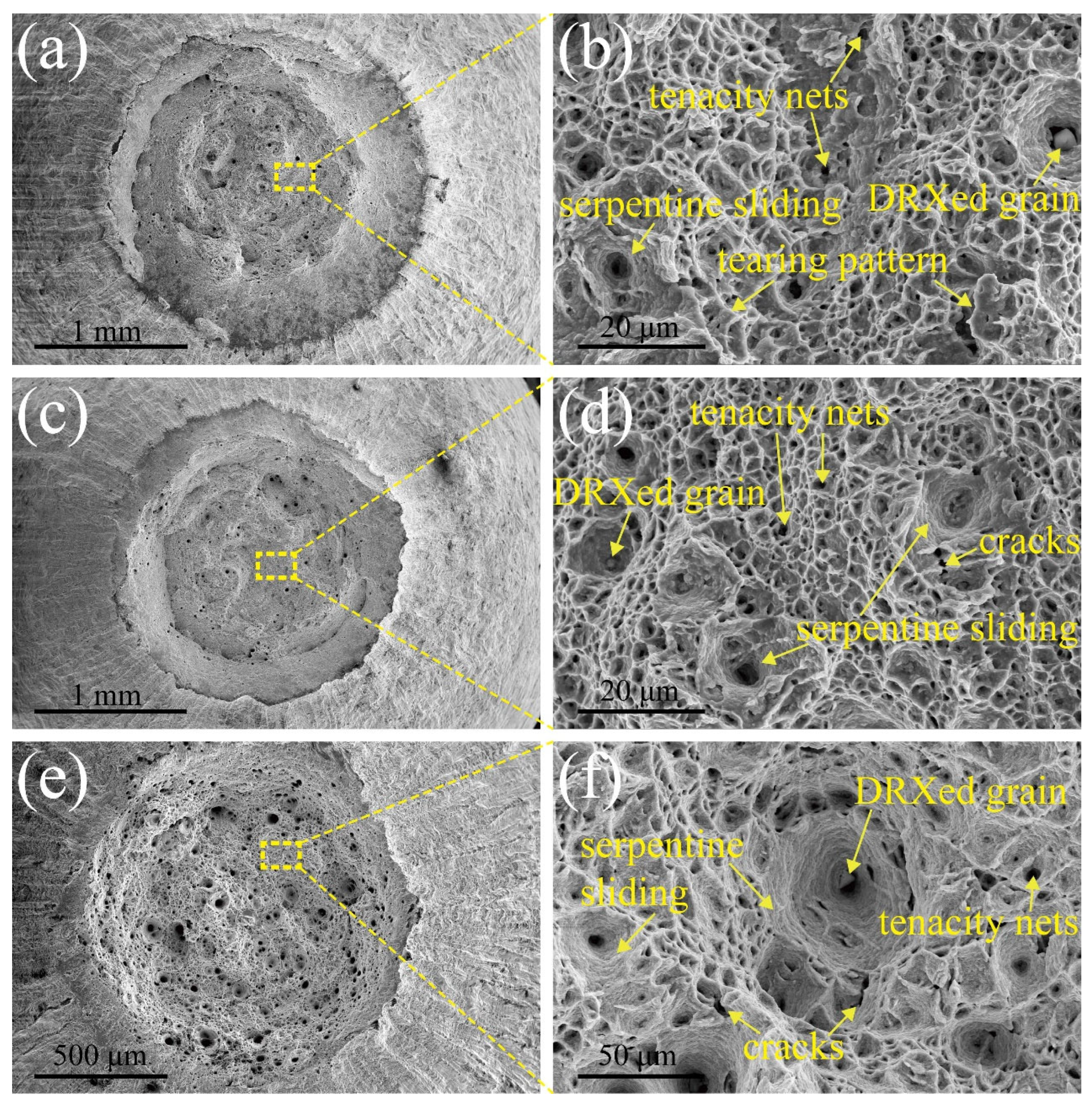

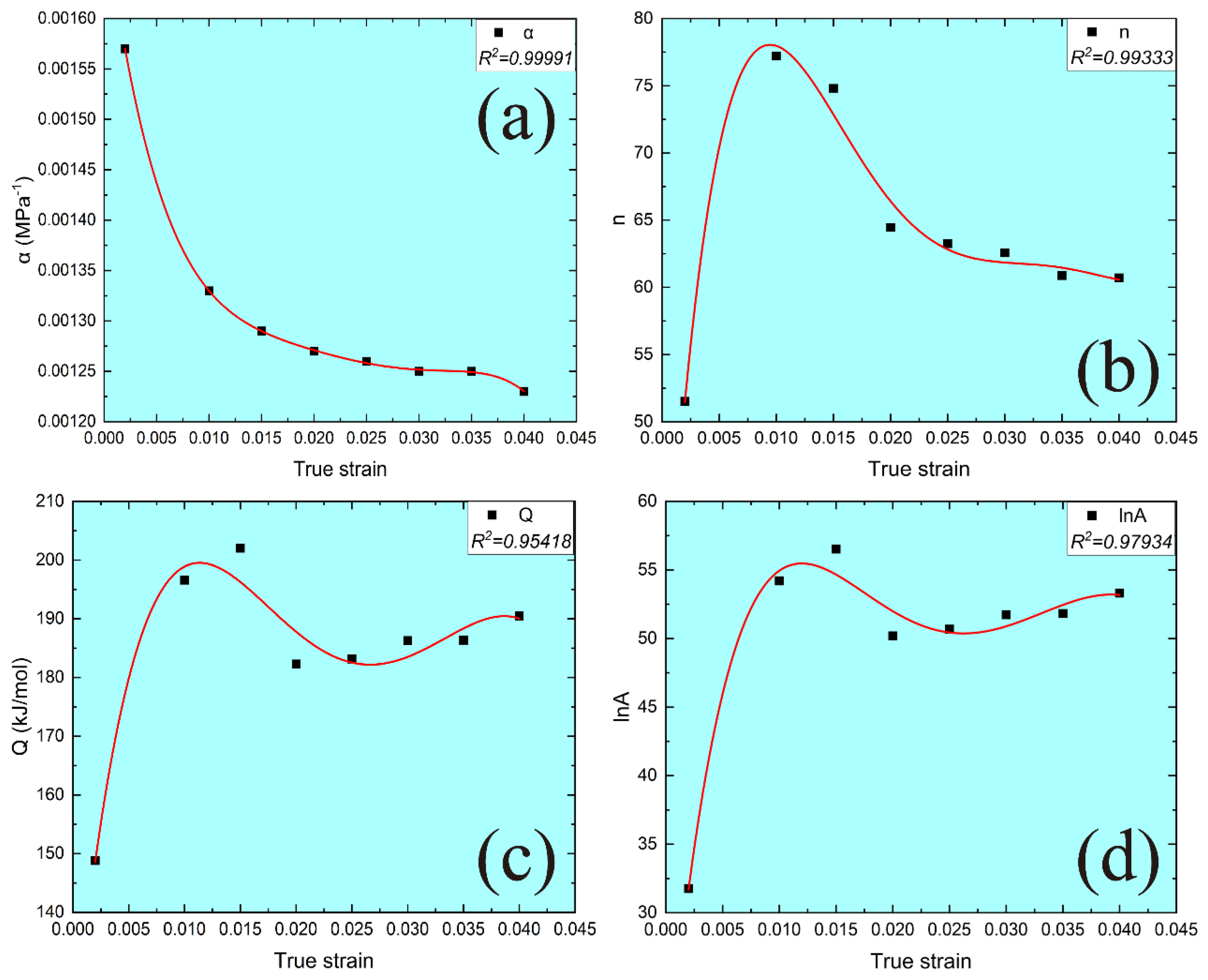
| C | Si | Mn | Cr | Mo | Ni | W | Co | V | Fe |
|---|---|---|---|---|---|---|---|---|---|
| 0.12 | 0.06 | 0.06 | 8.95 | 0.15 | 0.16 | 2.80 | 2.84 | 0.2 | Bal |
| Precipitate | Element | C | Cr | Fe | W |
|---|---|---|---|---|---|
| A | Mass fraction | 1.14 | 22.88 | 35.41 | 40.57 |
| B | Mass fraction | 1.79 | 46.97 | 38.09 | 13.15 |
| C | Mass fraction | 0.65 | 8.38 | 89.65 | 1.32 |
| Temperature/°C | Strain Rates/s−1 | Yield Strength/MPa | Tensile Strength/MPa | Elongation/% | ||
|---|---|---|---|---|---|---|
| RT | 5 × 10−3 | 699.05 | 907.88 | 11.92 | 0.062 | 0.607 |
| 5 × 10−4 | 651.64 | 891.66 | 12.38 | 0.053 | 0.560 | |
| 5 × 10−5 | 625.76 | 864.72 | 11.45 | 0.047 | 0.532 | |
| 630 | 5 × 10−3 | 439.25 | 515.58 | 12.72 | 0.047 | 0.572 |
| 5 × 10−4 | 406.18 | 508.46 | 14.87 | 0.011 | 0.528 | |
| 5 × 10−5 | 256.73 | 358.05 | 17.26 | 0.004 | 0.342 |
| Parameters | |||||||
|---|---|---|---|---|---|---|---|
| Average-value | 68.700 | 0.108 | 51.523 | 164.983 | 128.988 | 148.833 | 0.00157 |
| True Strain | ||||
|---|---|---|---|---|
| 0.002 | 0.00157 | 51.523 | 148.833 | 31.768 |
| 0.01 | 0.00133 | 77.211 | 196.589 | 54.205 |
| 0.015 | 0.00129 | 74.807 | 202.045 | 56.527 |
| 0.02 | 0.00127 | 64.452 | 182.299 | 50.189 |
| 0.025 | 0.00126 | 63.257 | 183.151 | 50.689 |
| 0.03 | 0.00125 | 62.577 | 186.303 | 51.741 |
| 0.035 | 0.00125 | 60.877 | 186.336 | 51.821 |
| 0.04 | 0.00123 | 60.710 | 190.491 | 53.315 |
Publisher’s Note: MDPI stays neutral with regard to jurisdictional claims in published maps and institutional affiliations. |
© 2022 by the authors. Licensee MDPI, Basel, Switzerland. This article is an open access article distributed under the terms and conditions of the Creative Commons Attribution (CC BY) license (https://creativecommons.org/licenses/by/4.0/).
Share and Cite
Cai, Y.; Wang, Q.; Liu, M.; Jiang, Y.; Zou, T.; Wang, Y.; Li, Q.; Pei, Y.; Zhang, H.; Liu, Y.; et al. Tensile Behavior, Constitutive Model, and Deformation Mechanisms of MarBN Steel at Various Temperatures and Strain Rates. Materials 2022, 15, 8745. https://doi.org/10.3390/ma15248745
Cai Y, Wang Q, Liu M, Jiang Y, Zou T, Wang Y, Li Q, Pei Y, Zhang H, Liu Y, et al. Tensile Behavior, Constitutive Model, and Deformation Mechanisms of MarBN Steel at Various Temperatures and Strain Rates. Materials. 2022; 15(24):8745. https://doi.org/10.3390/ma15248745
Chicago/Turabian StyleCai, Yifan, Quanyi Wang, Meng Liu, Yunqing Jiang, Tongfei Zou, Yunru Wang, Qingsong Li, Yubing Pei, Hong Zhang, Yongjie Liu, and et al. 2022. "Tensile Behavior, Constitutive Model, and Deformation Mechanisms of MarBN Steel at Various Temperatures and Strain Rates" Materials 15, no. 24: 8745. https://doi.org/10.3390/ma15248745






